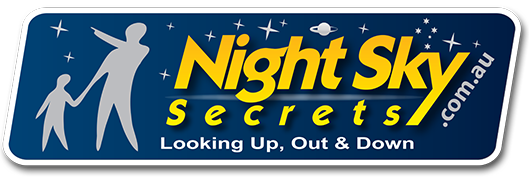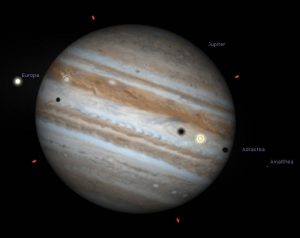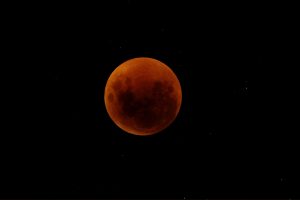The Planets
Mercury In August is now visible in the evening sky all month reaching its greatest eastern elongation at 27 deg to the east of the sun on the 13th, and on the 21st is in close conjunction with Jupiter. By mid September it has again returned to conjunction with the sun and is no longer visible. It is worth taking a look at Mercury in August through a Telescope as it displays “phases” in the same fashion as the moon and Venus.
Venus makes a spectacular return to our western Sky in August and on the 4th makes a close apparition with the 1 day old moon and the bright star Regulus in Leo. Again on the 27th and 28th it is very close to Jupiter at just 1/2 a degree (one full moon width) apart. The conjunctions continue into early September with a close encounter with the slender 2 day old cresent moon on the 3rd & on the 16th is just a few degree’s from the bright star Spica in Virgo.
Mars leaves Libra in early August and passes through the claws of the scorpion before entering into Ophiuchus for the first 3 weeks & then Sagittarius in the later part of the month. It has a couple of very pleasing apparitions visible through a telescope on the 6th & 7th with the Globular Cluster M19 & the impressive double star 36 Ophiuchi on the 11th and 12th.
Jupiter makes its last big bold statement with the aforementioned conjunction with Venus, appearing like a bright set of “eyes” in the western sky on the 27th and 28th of August. In September it is lost to conjunction with the sun on the 26th.
Saturn is well placed for early evening viewing in August, transiting the meridian (highest point) at around 7pm mid month where forms a wide triangle with Mars and the bright star Antares. Saturn moves into the north western sky in September.
Uranus is now rising in the eastern sky in the late evening in Pieces in August & is just visible to the keen eyed observer with the Naked Eye under clear moonless skies at Magnitude 5.7. So if you have ever wanted to see Uranus with the naked eye * Please no uranus jokes 🙂 * now is the time, with the aid of a finder chart. (In astronomy circles we pronounce the name UR-UN-US, just to avoid any confusion !)
Neptune is at Opposition in Aquarius on the 3rd of September & is still too feint to be seen with the naked eye by more than one full magnitude at mag: 7.8, if you have a telescope though, you should look for it at least once !
Meteor Showers: August sees the very reliable, and one of my Favourite meteor showers the Perseids, grace the early morning skies. This reliable shower has records of it dating back 1000’s of years and usually produces about 60 meteors per hour for those of us in far northern Australia.
The peak day is the 13th of August and with the moon setting around 2:30 am the shower is well placed for great views. It always pays to look one night before and after the peak as the actual peak time can vary by a day either way. Find a comfortable position facing NE, relax, recline and look up from 3:30am (this is one for the early risers)
Other Activities: Keep an eye on the Facebook page of “FNQ astronomers” set up by NightSkySecrets as a community observing group and to notify residents of FNQ of the big events in our night & daytime sky. There are many other deep sky delights to be seen if you have binocular or a telescope and if your keen, come and see us at The Pier at the NightSkySecrets store, where we can fill you in on the hidden secrets of the Night Sky.
Astronomy is – looking Up !
Observing Equipment Advice
Naked Eye Viewing: This is the best way to see Meteor Showers, the board sweep of the Milky Way & track satellites across the night sky. Choose as dark site and a comfortable reclining position. This is FREE and just takes a bit of effort 🙂
Big Star clusters: we are talking about groupings of stars that are beyond a fuzzy blob, these are things like the clouds of Magellan, the Pleiades & a few selected nebulous regions. These are best seen with a pair of 7x to 10x Magnification binoculars with a 50mm lens. Prices start from around $100.
Fuzzy Blobs: You can’t make out what they are but you think they might be interesting ? These are best seen with a wide field telescope, starting price is around $250. These scopes gives you a nice contrast against the blackness of space.
The Invisible: Galaxies, faint nebula & planetary details, this is where Telescopes 6” in aperture and above come into play, these start at around $400 and how big you go is only limited by portability and budget (The biggest have 48” or 1.2m mirrors !)


